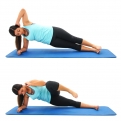Get Rid of Your Low Back Pain Today!
Effectively & Efficiently
If you're older than 30, chances are you've experienced low back pain at some point in your life. If you're younger than 30, maybe you've experienced it too. Just because low back pain is an extremely common musculoskeletal pain impairment doesn't mean you have to continue to suffer with the pain. Figuring out what to do about your back pain can be confusing, especially in a large city like Denver, CO with so many providers offering services to treat spine pain. Start feeling better today by implementing these 7 easy things in your life to reduce your low back pain.
- Work Station Set Up: Sitting at a desk all day, or even just for a few hours, can create a lot of load through your spine. The ideal work station set-up involves sitting in a chair that allows your feet to be flat on the ground with your knees and hips bent to 90deg. You should be able to sit all the way back in your chair with the small of your back supported by the chair or a small pillow. Even with the best work station set-up it is very helpful to stand and/or take a quick walk every hour. Buy my favorite ergonomic and adjustable work chair here.
- Sleeping Position: Sleep is the ideal time for tissue remodeling and healing; sleeping with good spinal alignment can improve this process. If you are a back sleeper, put 1-2 pillows under your knees to help your pelvis rest in a neutral position and reduce the lordosis of your low back. If you are a side sleeper, try putting 1-2 pillows between your knees to reduce the side bend of your middle and low back. In general, a firmer mattress will help support your body better and allow for better spinal alignment.
- Gentle Stretches to Reduce Pain: Gently stretching your hips and lumbar paraspinals can greatly reduce pain by decreasing tightness and spasms as well as help "open up" your spinal segments. Stretching can include child's pose, reclined butterfly, single knee or double knee to chest, angry cat, and figure 4 stretch in sitting or laying down.
- "Core" Activation with Movement: Your Transverse Abdominus is a deep core muscle that works like a girdle when activated. It is attached to each low back spinal segment and helps stabilize the spine with activated properly. To activate this muscle work on gently tightening your stomach muscles by pulling your belly button to the base of your neck; the activation should feel like you're gently pulling up and in. Pilates is a great way to improve your core activation. My favorite Denver Pilates studio is UP Pilates in the Highlands.
- Proper Lifting Mechanics: When lifting something more than 10 lbs be sure to set yourself up for success. By using good body ergonomics you can reduce injury and/or aggravation of low back symptoms. Key things to remember when lifting something are to engage your core, lift with your legs (i.e. bend at your knees vs. at your spine), keep your hips and shoulders square to avoid rotating, and get help if it is too heavy.
- Motion is Lotion: Joints, muscles, and spinal discs feel better with regular movement. Taking a 15-20 minute walk during the day is a great way to keep your spine lubricated and moving. Find a walking ground on Denver Meetup.
- Use Ice or Heat: Ice is a great way to manage and reduce acute pain flare-ups. Heat is a great modality to use when you feel "tight" or "spasms" in your low back or hip muscles. Always use a layer between ice or heat and your skin to avoid frost-bite and burns. Buy my favorite hot/cold pack here.
If these suggestions help but you are still experiencing pain that is interfering with your quality of life, it is time to dig a little deeper. Low back pain can vary based on the type of pain, location of symptoms, duration of impairments, mechanism of injury, age, and work/life duties. As a physical therapist and personal trainer with extensive experience with spine pain, I can help get to the root cause of your symptoms and develop a treatment plan personalized to you. Common symptoms that require more specialized care include: numbness or tingling into your legs/feet, weakness of your legs, history of spinal surgery, shooting pain into one or both of your legs, and/or difficulty moving due to pain. Treatment strategies may include manual therapy, exercise, trigger point dry needling, yoga, myofascial release, and neuromuscular reeducation to improve movement patterns. Even though low back pain is common, there are many ways to help address it to help you feel better and live better.
Schedule an appointment here: https://www.physioyogaandwellness.com/book-online
Email me directly: Jessica@physioyogaandwellness.com

0

0





Comments :